About
Introducing British Columbia’s New Builders Lien Act

The purpose of this pamphlet is to assist participants in British Columbia’s construction industry to better understand the operation of the new Builders Lien Act. It is not intended as legal advice and the Act itself should be consulted in all cases by persons concerned with their rights and obligations under it. Many of the general rules described are subject to qualifications and exceptions in particular circumstances.
This pamphlet was prepared by the British Columbia Law Institute, at the request of the then British Columbia Ministry of Employment and Investment. The British Columbia Law Institute is a nonprofit body whose mission is to clarify and modernize the law. The work of the Institute is supported by the Law Foundation of British Columbia.
Canadian Cataloguing in Publication Data
Main entry under title:
Introducing British Columbia’s new Builders Lien Act
Prepared by the British Columbia Law Institute.”–Added t.p.
Co-published by Ministry of Attorney General.
ISBN 0-7726-3283-9
1. British Columbia. Builders Lien Act. 2. Liens – British Columbia. 3.
Building laws – British Columbia. I. British Columbia. Ministry of
Employment and Investment. H. British Columbia. Ministry of Attorney
General. Ill. British Columbia Law Institute.
ICEB271.5.L54IS7 1997 346.71 1’02’4 C97-960172-X
KFIOS8.I57 1997
Background
Builders’ lien legislation has been part of British Columbia law for almost 120 years. Over the years it has been amended numerous times, but almost always these changes have been piecemeal, and failed to reflect any consistent set of guiding principles. The new Builders Lien Act, thoroughly revises this law to meet the needs of today’s construction industry.
This Act is the final stage of a process of law reform that started more than 25 years ago, including work carried out by the British Columbia Law Reform Commission and a Select Committee of the Provincial Legislature. The Act reflects extensive consultation carried out with the construction industry.
The Basic Aims of the Act
The basic aims of the Act are straightforward. It provides a form of security for the payment of money owed to persons such as contractors, subcontractors, workers and material suppliers who add value to a building that is under construction.
In providing this security, the Act is sensitive to the need to accommodate the legitimate interests of the owner/developer, the construction lender and other participants in the project.
The Act also aims to encourage the prompt payment of creditors throughout the project and ensure that money intended to finance the construction is, in fact, used for that purpose.
The Anatomy of a Construction Project
The Pyramid
To understand how the Builders Lien Act operates it is necessary to understand the legal and economic environment that surrounds a major construction project.
Typically, large numbers of persons will contribute to the project and their relationships are defined by the “chains” of contracts that link them together. Pictorially, these relationships resemble a pyramid like the one set out in Diagram 1: The Pyramid. This is sometimes referred to as “the construction pyramid” or simply “the pyramid.”
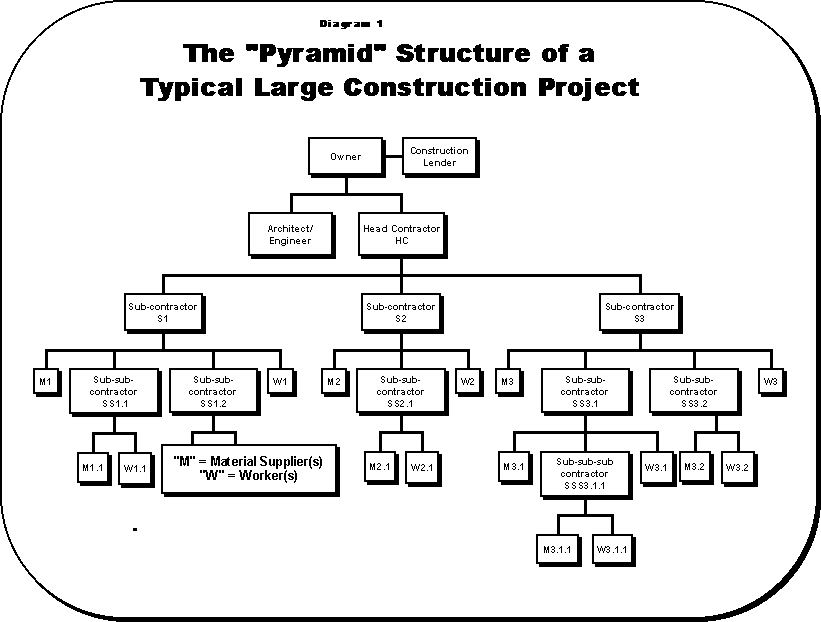
At the top of the pyramid is the owner/developer along with the construction lender who provides financing for the project. At the next level down are persons engaged directly by the owner. This may include architects, engineers and the head contractor. Further down, the pyramid broadens out with one or more layers of subcontractors and sub-subcontractors. Any of these persons may purchase building materials and hire workers in performing their part in the construction.
The various participants in the project are linked by chains of contract relationships that reach from the top of the pyramid to the bottom. The Act uses the word “engage” to indicate that two or more parties are in the same contract chain. One person is “engaged by” another when they contract directly with each other. When a person is “engaged under” another this means that they either have contracted directly or are linked through one or more intermediate parties. Sometimes, for greater certainty, the Act uses the expression “engaged by or under.”
See Diagram 2: Relationships Within the Pyramid.
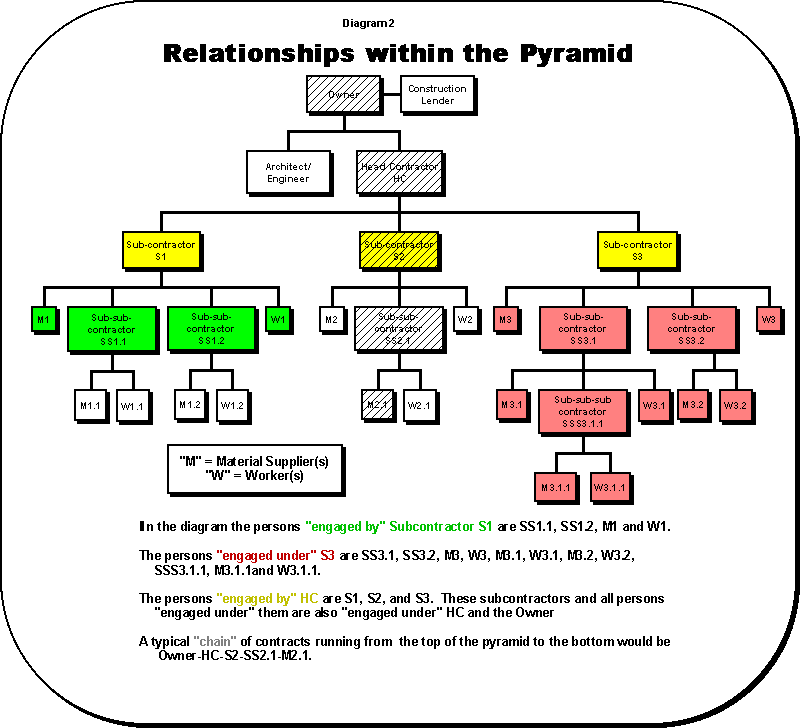
Apart from a Builders Lien Act, two persons in the pyramid have legal rights against each other only when one of them is “engaged by” the other. They must have a direct contract relationship.
See Diagram 3: Rights Other Than Builders’ Liens.
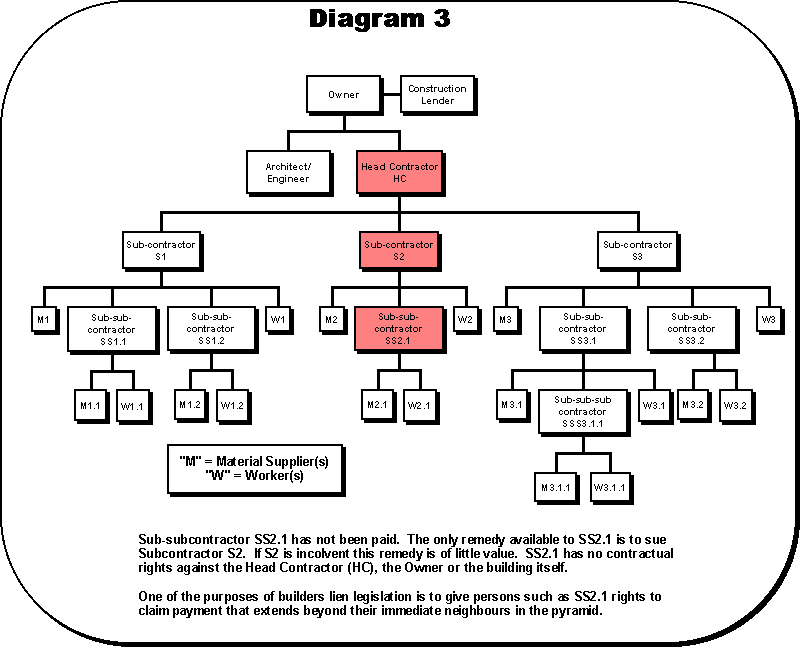
The Flow of Money and Credit
In the construction pyramid money flows from the top to the bottom. On a major project, the owner will normally finance it by borrowing from an outside lender whose interest is secured by a mortgage over the project. Typically, the mortgage money is advanced in stages (known as a “mortgage draw” or “progress payment”). These stages correspond with the various stages of completion of the project.
The mortgage draw is usually timed to coincide with the point at which the head contract entitles the contractor to receive a progress payment from the owner for the most recent work performed. On receiving a progress payment the head contractor will use some or all of the payment to pay its workers, suppliers and subcontractors. The subcontractors will, in turn, pay the persons they have engaged. Thus, money flows from the top of the pyramid to the bottom.
See Diagram 4: The Flow of Money.
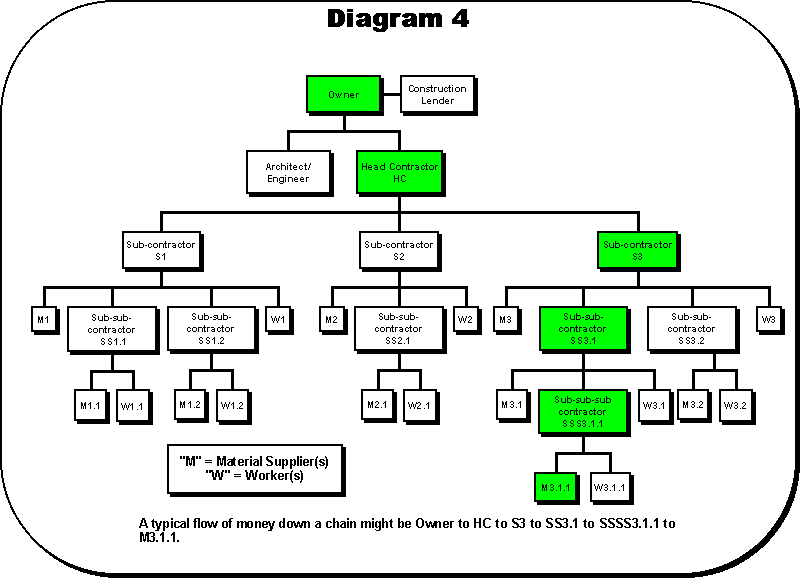
In contrast, credit is extended from the bottom of the pyramid toward the top. It is an important characteristic of construction financing that payment is normally made only after work that it pays for has been performed. This applies at all levels of the pyramid.
See Diagram 5: The Flow of Credit.
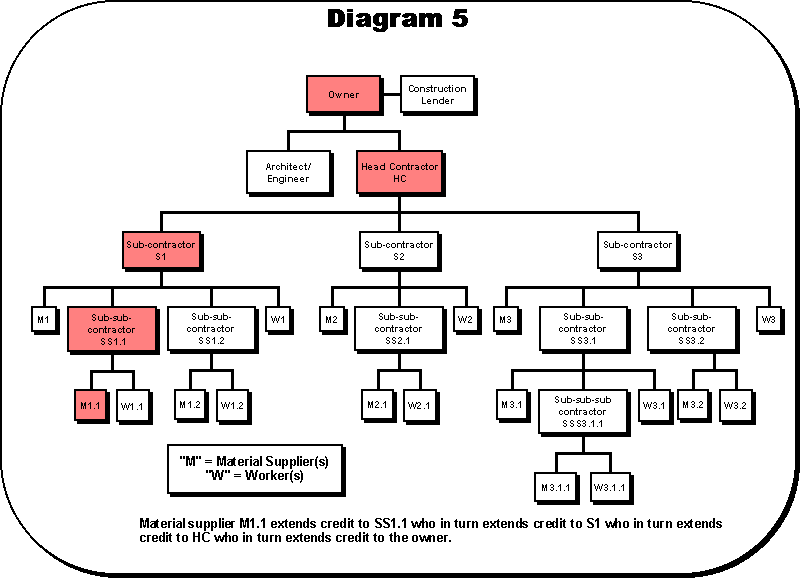
The flow of money down the pyramid from the top to satisfy the credit extended at the bottom is the lifeblood of a construction project. Anything that stops or slows that flow or allows money to escape from the pyramid can have serious consequences for those at the bottom.
Security and Holdbacks
“Primitive Security”
A basic aim of builders’ lien legislation is to provide a form of security for persons involved in a construction project. These persons may be directly engaged by the owner, such as the head contractor, or they may be workers, subcontractors, and material suppliers who are not engaged directly by the owner.
The most primitive way of providing security is simply to give these persons a lien over the building under construction. This was the basic strategy of the British Columbia legislation for many years, but as the construction industry grew more complex it was seen to be flawed.
One problem was that construction projects were often fully mortgaged and, until it was almost complete, the owner had little equity in the project and a lien was of little value. Also, it was seen as unfair to make the owner’s property liable for the payment of debts where the person actually in default was someone much lower in the pyramid over whom the owner had little or no control.
A result of introducing builders’ lien legislation was that a standard term came to be included in the head contract and in most subcontracts. The term was that the contractor or subcontractor promises the other party that the project would be kept “clear” of liens asserted by persons lower in the pyramid in the same branch of the chain of contracts.
See Diagram 6: The Obligation to Clear Liens.
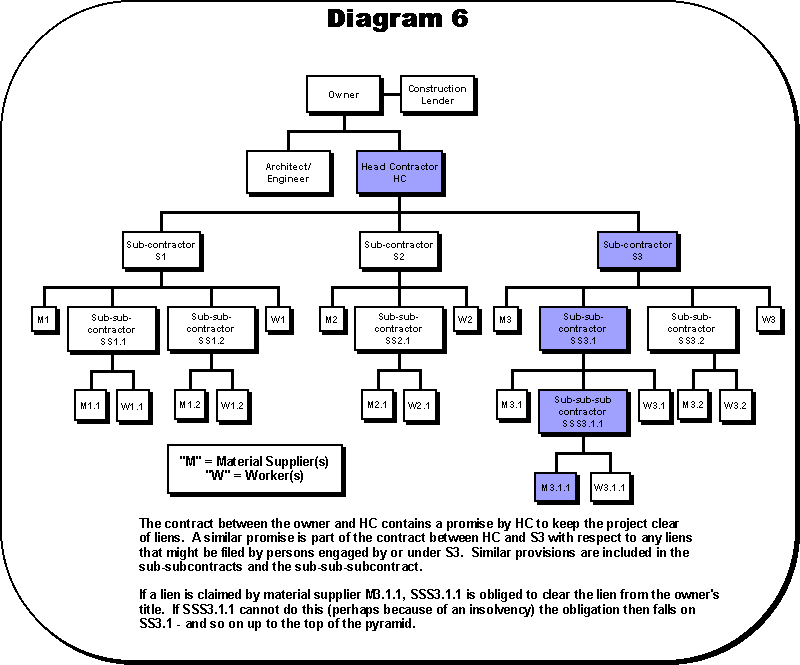
A Single Holdback Scheme – Limiting the Owner’s Liability
In 1956, in response to the weaknesses of the “primitive” lien system, the legislation was amended to require that the owner retain a certain percentage (now 10 per cent) of progress payments made to the head contractor. The amount retained was known as the “holdback.” Since only the owner was required to retain a holdback, this came to be known as the “single holdback scheme.” The owner’s holdback also became an asset that was subject to lien claims and it provided additional tangible security for their payment.
The owner’s holdback also provided a way of protecting the owner’s interest. It became a rule that the liability of the owner and of the building for the payment of lien claims could be satisfied by paying the holdback into court. So, as long as the owner retained the holdback, the project itself was insulated from lien claims.
The single holdback scheme had an unintended result. The risk of financial loss associated with liens was transferred from the owner to the head contractor. This occurred because the holdback, which is really the head contractor’s money, became security for lien claims.
The reaction of contractors was to retain informal holdbacks from payments to their subcontractors so if it became necessary to clear liens claimed by persons lower in the pyramid, funds were available to do this. But if the contractor is to be fully protected these informal holdbacks must, in total, be much larger than the owner’s holdback. This reflects the fact that the contractor’s liability is not limited like the owner’s.
These informal holdbacks have seriously obstructed the flow of money down the various branches of the construction chain and may, in fact, have led to the insolvency of subcontractors toward the bottom of the pyramid. This obstruction was seen as the single most important issue to be addressed by new legislation.
A Multiple Holdback Scheme – Extending Limited Liability
The multiple holdback scheme embodied in the new Act is intended to remedy these defects and encourage the flow of money from the top of the pyramid to the bottom. All persons who make payments under a contract or subcontract must retain a holdback (section 4). This holdback must be equal to 10 per cent of the value of the work or material provided or 10 per cent of any payment made on account.
See Diagram 7: Multiple Holdbacks.
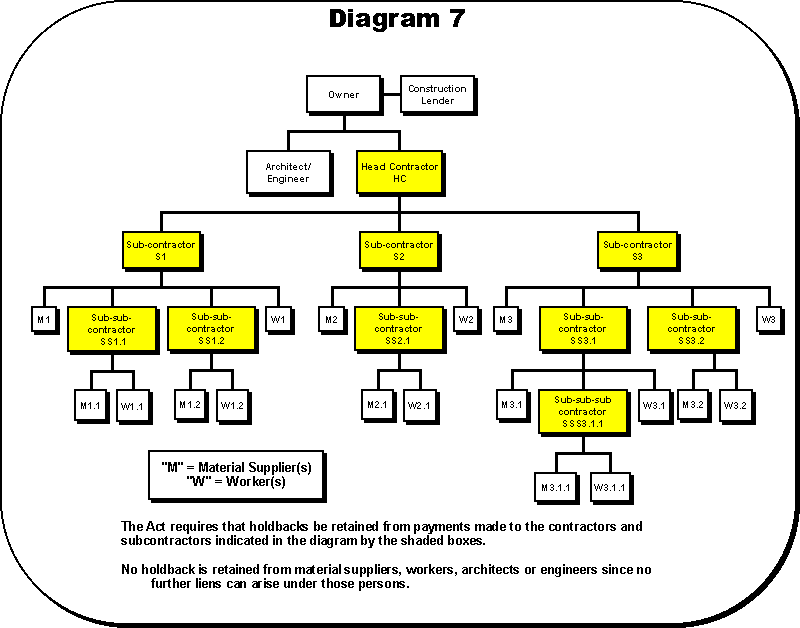
A holdback retained under the multiple holdback scheme has two aspects. First, it provides security for persons engaged by or under the contractor or subcontractor from whom the holdback was retained (section 4(9)). Second, it defines the maximum liability of the person who retains the holdback if it becomes necessary to clear liens arising under the person from whom the holdback was retained (section 34).
See Diagram 8: The Limited Liability Principle.
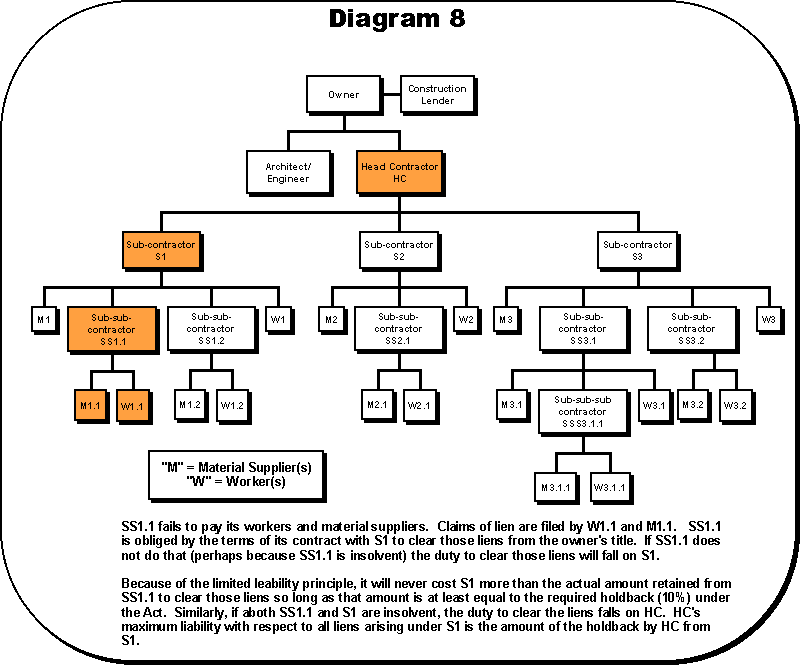
The Act reinforces the operation of the multiple holdback scheme in a number of ways.
Clearing Liens
An important feature is the ability to remove lien claims from the owner’s title through a payment into court. The amount which an owner, contractor, or subcontractor must pay into court is determined with reference to the limited liability principle. In most cases, a person can clear liens from the title by paying an amount equal to the holdback retained from the contractor or subcontractor under whom the liens arise.
See Diagram 9: Clearing Liens Under the Act.
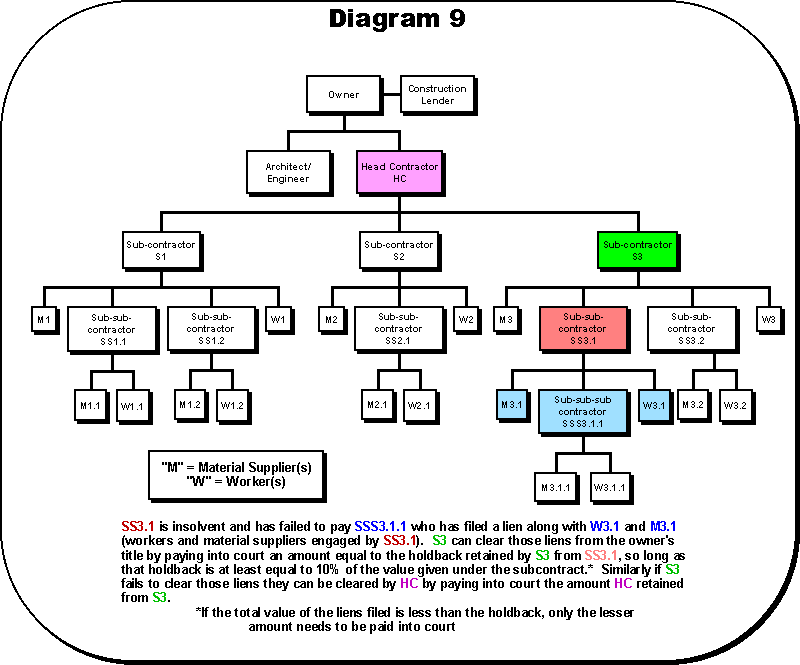
Distribution of Funds
The new Act provides a detailed scheme for the distribution of available holdback funds to various lien claimants (sections 36 to 38). In the distribution of these funds, priority is given to reimbursing lien claimants for their costs of filing and enforcing the liens. Next in priority is up to six weeks of worker’s wages.
Any money remaining after those priorities have been met is available to distribution in satisfaction of the remaining liens. The basic rule is pro rata distribution among lien claimants. In rare cases where distribution is complicated by the occurrence of two or more insolvencies among project contractors and subcontractors, it may be necessary to prorate twice; first, among various classes of lien claimant according to the amount owed the person who engaged the class and, second, among individual members of each class (“class” is defined in the Act).
See Diagram 10: Distribution of Funds.
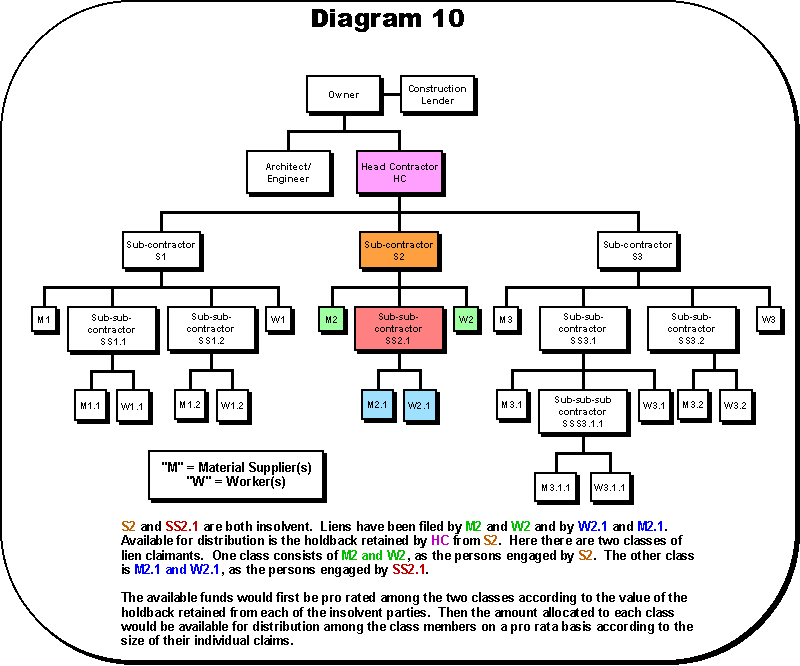
The distribution provisions appear to be complex but claimants will almost always have professional advice on their application in the rare instances when they are in issue.
The Holdback Account
The new Act creates special rules respecting holdbacks retained by the owner. A hold back retained from a person such as the head contractor must be an identifiable amount of money that is set aside and placed in a special bank account. Section 5 of the Act requires the creation of this “holdback account” to insure that funds will actually be available for the discharge of the owner’s remaining indebtedness at the conclusion of the project. If the owner acts as the project manager and engages several persons to do various aspects of the project, the owner must open a “holdback account” with respect to each contract.
Early Release of Holdbacks
The new Act permits the early release of holdbacks retained in relation to subcontracts which are completed before the construction project itself is complete. There are two important periods of time that affect the release of holdbacks. The first is the time limit for the filing of lien claims. The second is the time for the retention of holdbacks. Under the old single holdback scheme, for most parties these times were tied to the completion of the contract with the owner under which the lien arose. A lien claimant was formerly required to file a lien claim within 31 days of the completion of the contract, and the owner retained the holdback for 40 days following completion.
The new Act extends both of these times. Lien claimants are now given 45 days to file a lien (section 20) and the period for which a holdback is retained is now 55 days (section 8).
The events which can trigger the running of these two time periods have been revised. First, if there is a head contract, time runs from its substantial performance. Where there is no head contract, time runs from the substantial completion of the construction project itself.
Second, the new act introduces a procedure under which the architect, engineer or other person will certify that a particular contract or subcontract is now fully completed (section 7). Where a certificate is issued time begins to run both for filing lien claims arising under that contract or subcontract and for the release of the holdback retained from the contractor or subcontractor in question.
If the holdback period expires without any lien claims being filed, the holdback must be paid to the person from whom it was retained.
See Diagram 11: Effects of Certificate of Completion.
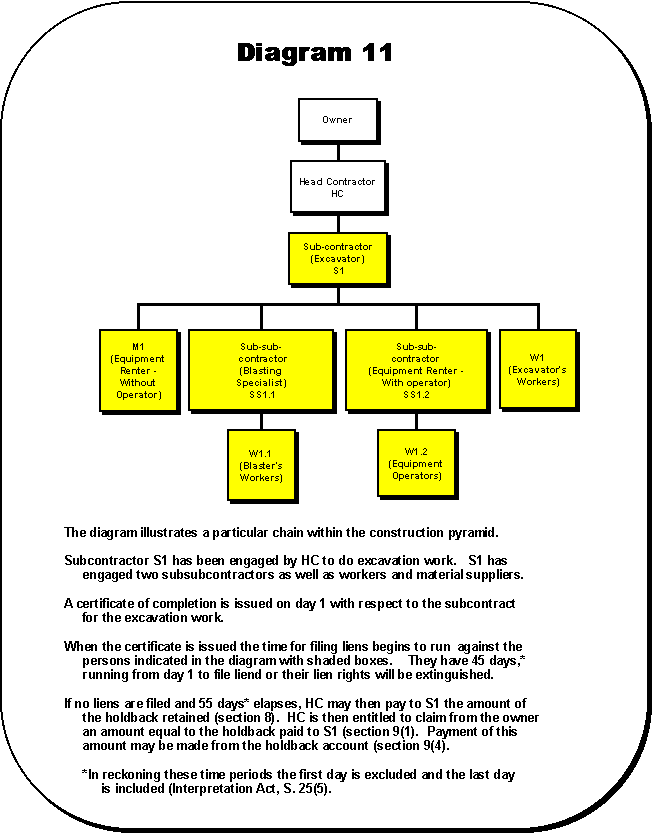
The early release of holdbacks, using the certificate procedure, is another feature of the multiple holdback scheme meant to encourage the flow of money within the pyramid.
Keeping Money Within the Pyramid
The Trust
The aim of the new Act is not only to encourage the flow of money down the construction pyramid, but to ensure that money stays within the pyramid and is not used for purposes that are unconnected with the construction project.
The most important technique used in the Act is to declare that any money received by a person that is meant to pay for work or materials performed or used in the project is subject to a “trust” in favour of subcontractors, material suppliers and workers (the beneficiaries) engaged directly by that person. The person who receives the money becomes a trustee.
See Diagram 12: The Statutory Trust.
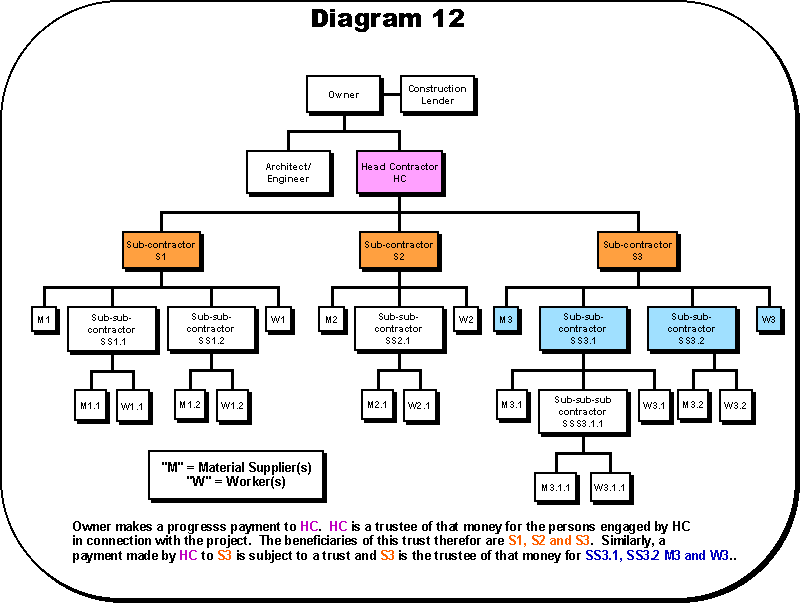
There are two important implications to the trust created by the Act. First, the trustee faces severe penalties if the trust money is used for a purpose other than satisfying the claims of the beneficiaries.
See Diagram 13: Breach of the Trust.
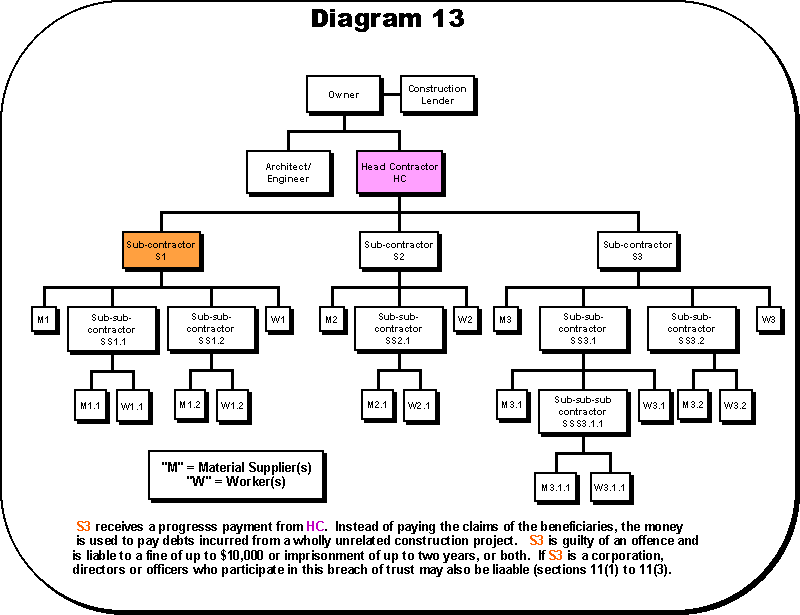
Another important implication of the trust created by the Builders Lien Act is that it continues to apply if the trustee becomes bankrupt. Ordinarily, on a bankruptcy all of the insolvent person’s assets are available to satisfy all creditors’ claims. The trust created by the Builders Lien Act ensures that money which becomes available in respect of a particular construction project is available exclusively to creditors of the insolvent person whose claims arise out of that project.
Other Techniques
The new Act adopts a number of other techniques to keep money within the contractual pyramid.
- It ensures that gamishment cannot be used to defeat the trust. Trust money paid into court under a garnishing order retains its character as trust money and can be dealt with only subject to the claims of the beneficiaries. Money in a holdback account is not subject to gamishment (section 13).
- The Act prohibits the assignment of money that may be due under a contract or subcontract (section 42).
- The Act alters a technical rule of law that otherwise allows a creditor to cause a payment to be credited to a debt that is not connected with the project under which it became available (section 12).
Some Other Features of the New Act
Filing Procedures
The new Builders Lien Act provides a simpler and more flexible filing procedure than the former Act. Parties have a longer period in which to file their claims. The claim form no longer takes the form of an affidavit which required the lien claimant to appear before a Commissioner or Notary Public to swear it. As under the former legislation, lien claims are filed in the Land Title Office.
Parties are entitled to file using an agent and an agent can represent more than one lien claimant with respect to a particular project. A single lien claim may be filed on behalf of all parties (section 15(2)). This may be particularly useful in allowing a union representative to file a claim on behalf of numerous workers.
The Act also addresses the situation where a single project extends over several parcels of land. The lien claimant is permitted to create a lien against each parcel of the land with a single filing (section 16).
Protection of Purchasers
The buyer of a home, is vulnerable to liens that may be filed after the purchase has “closed.” This is true of both newly constructed buildings and older homes which may be subject to liens arising out of renovations or repair work.
The new Act allows the buyer to retain a holdback from the seller – up to 10 per cent of the purchase price – which can then be used to discharge liens that appear after the sale is completed (section 4(7)). Most of the rules that apply to holdbacks retained from contractors and subcontractors apply to the purchaser’s holdback as well.
Other Features of the New Act
- Interested parties are given a comprehensive right to information in respect of the project so far as it is relevant to their rights under the Act (section 41).
- Lien claimants are given a right against insurance proceeds if the building is destroyed (section 44).
- The Act imposes increased penalties for a deliberate wrongful filing (section 45) and clarifies the right of the owner to seek damages (section 19).
- The Act requires that proceedings in relation to a construction project be brought in a court that is geographically close to the project (section 27).
- The definition of “wages” is expanded to embrace amounts payable under a collective agreement in relation to employee benefit plans and similar obligations (section 1).
- The protection of the Act is extended to architects and engineers.
- Landlords are given a simplified procedure to protect their property from liens arising out of unauthorized work ordered by their tenants (section 3(2)).
- The concepts of “substantial completion” and “substantial performance” are clarified (sections 1(2), 1(3)).
- The Act clarifies the right of an owner or contractor with respect to amounts retained in excess of the required 10% holdback. They may be applied to remedy a default by the person from whom the holdback was retained (section 6(3)).
- The court may order that priorities between lien claimants and a construction lender modified so further advances can be made by the lender to permit the completion of the project (section 32(4)).
Transition to a New Act
The Act sets out a number of rules for guidance on the difficult question of the application of the new Act to construction projects that are underway when it comes into force. The aim of these rules is to bring the benefits of the new Act to existing projects while maintaining the validity of things done in compliance with the legislation that formerly governed the project.
Where a dispute arises in relation to a project, the parties may apply to the court for directions as to the application of the transition rules to the circumstances of the dispute. The Act also contains a power to create, by regulation, additional transition rules to meet unforeseen circumstances.
Conclusion
This measure will give British Columbia the most modern builders’ lien law in Canada, but those who may rely on it should be aware that even the best Act has limitations. A Builders Lien Act can never do more than provide partial security. It does not guarantee lien claimants full recovery of the amounts owed to them.
Subcontractors and others who provide work and material on a construction project should be fully aware that they are extending credit just as surely as if they were lending money. Rights under the Builders Lien Act are no substitute for careful credit-granting practices and subcontractors and material suppliers should always check the financial integrity of those with whom they deal.








































